Recent Water Damage Posts
How SERVPRO Can Help with Frozen Pipes and Water Damage
1/20/2025 (Permalink)
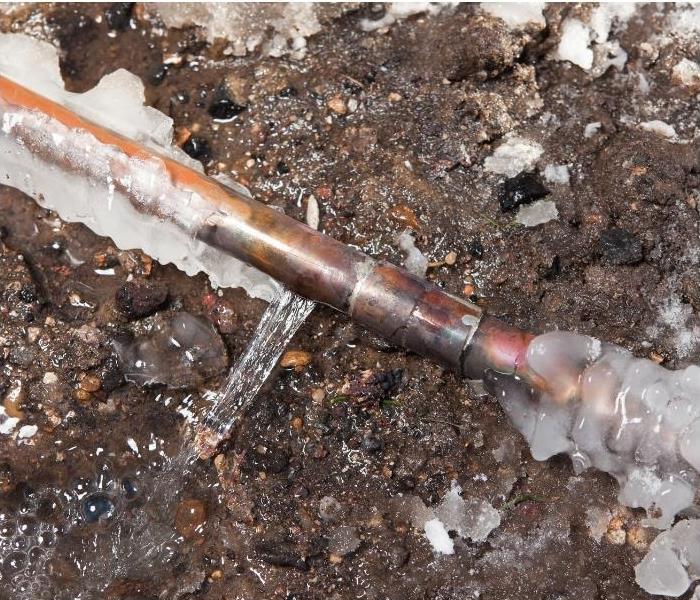 SERVPRO Can Help with Frozen Pipes and Water Damage in NE Salt Lake City, UT.
SERVPRO Can Help with Frozen Pipes and Water Damage in NE Salt Lake City, UT.
Winter brings many beautiful moments, from the coziness of holiday gatherings to the crisp air of snowy days. However, the colder months also bring a variety of home maintenance challenges, one of the most common being frozen pipes. When temperatures drop, pipes in uninsulated areas like basements, attics, and exterior walls are at risk of freezing. As the water inside them expands, it can cause pipes to burst, leading to serious water damage. Understanding how frozen pipes occur and the steps to take in case of a burst can help you protect your property from the costly consequences of water damage.
What Causes Pipes to Freeze?
Pipes freeze when the water inside them drops below freezing temperatures, causing the water to expand. This expansion puts pressure on the walls of the pipes, which can lead to cracks or even breaks. The most vulnerable pipes are typically those in areas without proper insulation, such as in garages, crawl spaces, or along exterior walls.
The risk of frozen pipes increases during extreme cold spells, especially when there is a prolonged period of subfreezing temperatures. Even homes that are well-insulated can be affected if there are drafts or areas where the insulation is compromised.
Once a pipe freezes, the water supply to that part of the house is interrupted, and when the ice melts, it can cause water to leak out, leading to serious flooding and water damage. Often, the real damage occurs after the pipe bursts, as water pours out and spreads quickly across the property.
Common Signs of Frozen Pipes
It’s crucial to spot the early signs of frozen pipes before they burst. Here are some common indicators:
- Reduced Water Flow: If the water pressure drops suddenly or water flow becomes weak, it may be due to frozen pipes.
- Frost on Pipes: If you notice frost or condensation on pipes, it could be a sign they are freezing.
- Strange Odors: In some cases, frozen pipes can lead to odors if they are located near drains or have been clogged.
- Unusual Sounds: If you hear banging or clanging sounds from your pipes, this could be the result of frozen water inside.
If you detect any of these signs, it’s important to act quickly before the situation worsens.
The Dangers of Burst Pipes
When a pipe bursts due to freezing, the situation becomes much more urgent. A burst pipe can release a large volume of water in a short amount of time, causing extensive water damage to flooring, drywall, insulation, and furniture. Water quickly spreads throughout a property, seeping into walls, ceilings, and flooring, leading to structural damage and, in some cases, the growth of mold.
Water damage from burst pipes can affect your home in several ways:
- Water Soaks Into Walls and Ceilings: Walls and ceilings can absorb water, which not only damages the material but can also create a breeding ground for mold and mildew.
- Flooded Basements and Crawlspaces: If a burst pipe occurs in a basement or crawlspace, water can quickly accumulate and cause significant damage to the foundation, insulation, and stored belongings.
- Damage to Electrical Systems: Water coming into contact with electrical systems can create a major safety hazard, potentially causing electrical shorts and fires.
- Mold Growth: Stagnant water from burst pipes provides an ideal environment for mold to grow. Mold can begin to spread within 24–48 hours, worsening the damage to your home.
How SERVPRO® Can Help with Frozen Pipes and Water Damage
SERVPRO of NE Salt Lake City is a trusted leader in water damage restoration, offering expert services to handle the aftermath of frozen pipes.
Here’s how SERVPRO can help:
1. 24/7 Emergency Response
Frozen pipes can cause immediate and severe damage, so quick action is essential. SERVPRO’s team is available 24/7 to respond to emergencies. Whether it’s late at night or during a holiday weekend, we are always ready to take action and prevent further damage. Our rapid response ensures that the water is contained and mitigation starts as soon as possible, helping to minimize the overall damage to your home.
2. Water Extraction and Cleanup
Once a pipe has burst, water can quickly spread across floors, walls, and ceilings. SERVPRO® has advanced water extraction equipment, such as industrial-grade pumps and vacuums, to remove standing water efficiently. Our team can also remove wet materials like carpeting, flooring, drywall, and insulation, which are often irreparable after being saturated with water.
3. Drying and Dehumidification
After the initial water extraction, it’s crucial to dry out the affected areas completely to prevent long-term issues like mold growth. SERVPRO uses high-powered air movers and dehumidifiers to dry both visible and hidden areas of your home. These specialized tools ensure that water trapped in walls, ceilings, and under flooring is removed, preventing further damage.
4. Mold Remediation
Mold is a serious concern after water damage from frozen pipes. If water damage is not dealt with quickly and properly, mold can begin to grow within 24–48 hours. SERVPRO offers mold remediation services to detect and remove mold from your property. Our technicians use advanced equipment to locate mold colonies, and we follow strict guidelines for safe removal to ensure the health and safety of your home and family.
5. Water Damage Restoration
After addressing the immediate water damage, SERVPRO can restore your property to its pre-damage condition. We handle everything from replacing flooring and drywall to repairing structural damage. Our goal is to make it “like it never even happened,” restoring your home to its original state.
6. Insurance Assistance
Dealing with the aftermath of water damage can be overwhelming, especially when it comes to working with insurance. SERVPRO of NE Salt Lake City can assist with the insurance claims process, working directly with your insurance company to ensure that the claim is handled smoothly and that you receive the proper coverage for the repairs and restoration.
Prevention Tips for Avoiding Frozen Pipes
While SERVPRO is here to help in the event of frozen pipes and water damage, prevention is always the best course of action. Here are some tips to help prevent frozen pipes:
- Insulate Vulnerable Pipes: Insulate pipes in attics, basements, and exterior walls. Foam pipe insulation or heat tape can prevent pipes from freezing.
- Keep the Heat On: Even if you’re away from home, leave the heat on to maintain a warm temperature, especially in colder areas of the home.
- Open Cabinet Doors: If temperatures are dropping, open the cabinet doors under sinks to allow warm air to circulate around the pipes.
- Let Faucets Drip: Letting faucets drip slightly can prevent pressure from building up in the pipes and help prevent freezing.
Frozen pipes and water damage are serious threats to your home during the winter months, but SERVPRO of NE Salt Lake City is here to help. With our 24/7 emergency response, water extraction, drying, mold remediation, and restoration services, we can restore your home quickly and efficiently. By acting fast and reaching out to SERVPRO, you can minimize the damage caused by frozen pipes and get your home back to normal in no time.
If you’ve experienced water damage from frozen pipes, contact SERVPRO of NE Salt Lake City today for immediate assistance and professional restoration services.
Essential Fall Home Maintenance Tips for Salt Lake City Homeowners
10/22/2024 (Permalink)
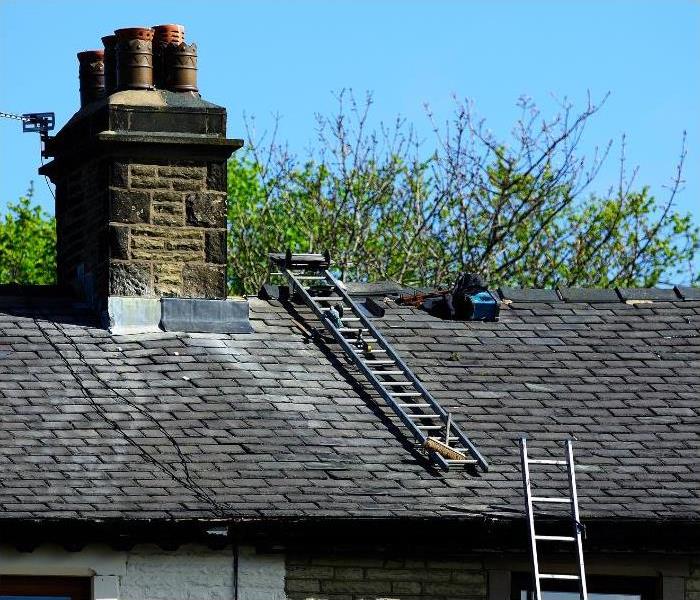 Essential Fall Home Maintenance in Salt Lake City, UT
Essential Fall Home Maintenance in Salt Lake City, UT
As the vibrant hues of autumn foliage blanket the streets of Salt Lake City and the air becomes crisp, it's a clear sign that winter is on its way. Preparing your home for the colder months ahead is crucial for maintaining its integrity, safety, and comfort. By taking proactive steps during fall, you can avoid costly repairs and ensure that your home remains a warm and welcoming space throughout the winter. Here are some essential fall home maintenance tips tailored specifically for Salt Lake City homeowners.
1. Roof Inspection
The roof is your home’s first line of defense against the elements, making it vital to inspect it before the winter weather sets in.
What to Look For:
Shingles: Check for missing, damaged, or curled shingles. If you notice any issues, address them immediately to prevent leaks.
Flashing and Sealants: Inspect the flashing around chimneys, vents, and skylights. Ensure sealants are intact and replace any that are cracked or peeling.
Gutters: Clogged gutters can lead to significant roof damage and ice dams in the winter. Make sure to clean out any leaves or debris to facilitate proper drainage.
If you're uncomfortable inspecting your roof yourself, consider hiring a professional roofing contractor to assess its condition.
2. Gutter Maintenance
Once your roof is in good shape, focus on the gutters and downspouts. Properly functioning gutters are crucial for directing water away from your home and preventing foundation issues.
Steps to Take:
Clean the Gutters: Remove leaves, twigs, and debris that may have accumulated over the summer months.
Check for Damage: Look for sagging sections or leaks and make repairs as needed.
Install Gutter Guards: Consider investing in gutter guards to reduce the frequency of cleanings and prevent future clogs.
3. Heating System Check
As temperatures drop, ensuring that your heating system operates efficiently is essential for your comfort and energy savings.
What to Do:
Replace Air Filters: Check and replace your heating system's air filters to improve airflow and efficiency.
Schedule a Professional Tune-Up: A qualified technician can clean and inspect your system for any potential issues, ensuring it runs smoothly all winter long.
Test Your Thermostat: Make sure your thermostat is functioning correctly. Consider upgrading to a programmable model to save on energy costs.
4. Insulation Assessment
Proper insulation is vital for maintaining a comfortable temperature and minimizing energy bills.
Check for Gaps:
Attic and Crawl Spaces: Inspect insulation in your attic and crawl spaces, ensuring there are no gaps or compressed areas.
Seal Drafts: Use caulk or weather stripping around windows and doors to prevent drafts, ensuring your home remains cozy and energy-efficient.
5. Winterize Outdoor Spaces
Preparing your outdoor areas for winter can protect your investments and prevent damage during heavy snowfall.
Steps to Winterize:
Drain Hoses and Sprinklers: Disconnect hoses and drain any water to prevent freezing. If you have an irrigation system, be sure to winterize it.
Store Outdoor Furniture: Clean and store patio furniture, grills, and other outdoor items in a shed or garage to prolong their lifespan.
Trim Trees and Shrubs: Trim any overgrown branches that could break under the weight of snow and potentially damage your home or vehicles.
6. Inspect Smoke and Carbon Monoxide Detectors
Safety is paramount, especially during the winter months when heating systems are in use.
Action Steps:
Test Detectors: Test smoke and carbon monoxide detectors to ensure they are functioning properly. Replace batteries if needed.
Replace Old Detectors: If your detectors are more than ten years old, consider replacing them for optimal safety.
7. Review Fire Safety Measures
With the colder weather, you'll likely be using heating appliances more frequently. Take this opportunity to review your fire safety measures.
Tips for Fire Safety:
Inspect Chimneys and Fireplaces: If you have a fireplace, schedule a professional cleaning to remove creosote buildup and ensure it operates safely.
Keep Fire Extinguishers Accessible: Make sure fire extinguishers are easily accessible and charged, particularly in areas where you use heat sources.
8. Prepare for Snow Removal
Living in Salt Lake City means preparing for snow during the winter months. Be proactive by gathering your snow removal supplies now.
Preparation Steps:
Stock Up on Supplies: Purchase ice melt, shovels, and snow blowers if needed.
Establish a Snow Removal Plan: Designate who will be responsible for snow removal and ensure they are equipped and ready for winter storms.
9. Create an Emergency Kit
With winter weather can come power outages and emergencies. Being prepared can make all the difference.
Contents of an Emergency Kit:
Flashlights and Batteries: Ensure you have working flashlights and extra batteries on hand.
First-Aid Supplies: Keep a well-stocked first-aid kit in an easily accessible location.
Non-Perishable Food and Water: Stock up on canned goods and bottled water to last at least 72 hours in case of emergencies.
10. Final Checklist
Before winter arrives, create a final maintenance checklist to ensure you haven’t overlooked any important tasks.
Checklist Items:
- Inspect and clean your roof and gutters.
- Check and service your heating system.
- Review insulation and seal drafts.
- Winterize outdoor spaces.
- Test safety devices and review fire safety measures.
- Prepare for snow removal and emergencies.
Taking the time to perform these fall maintenance tasks can save you from costly repairs and ensure a warm, safe, and comfortable winter in Salt Lake City. By being proactive, you can protect your home, enhance its energy efficiency, and enjoy peace of mind throughout the season. Embrace the beauty of fall and winter, knowing that your home is well-prepared for whatever the weather brings. Happy fall, and here’s to a cozy winter!
Navigating Nature: 5 Essential Tips to Reduce Flooding Risks in Salt Lake City, UT
5/18/2024 (Permalink)
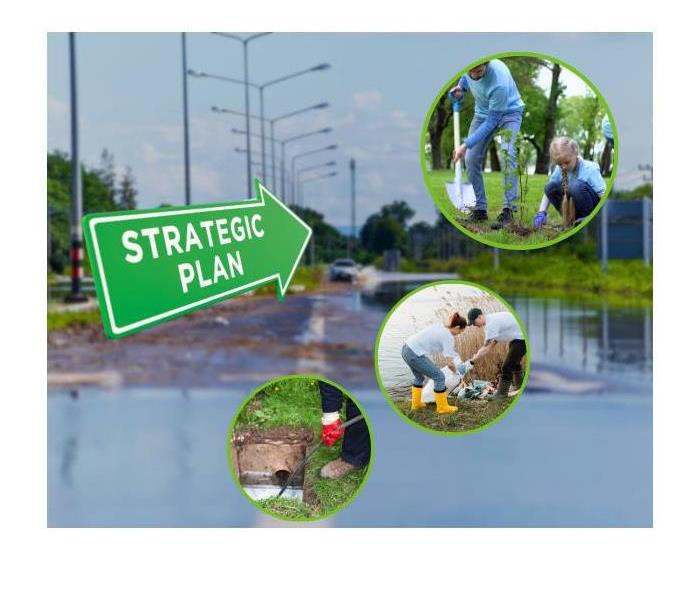 Strategies for a sustainable future in Salt Lake City.
Strategies for a sustainable future in Salt Lake City.
Salt Lake City, nestled against the backdrop of the stunning Wasatch Mountains, is a vibrant metropolis renowned for its outdoor recreational opportunities, cultural attractions, and thriving economy. However, like many urban centers, it faces the perennial challenge of managing flooding risks, particularly during the spring thaw or heavy rainstorms. With a proactive approach and strategic measures, residents and authorities can mitigate these risks and safeguard their communities. Here are five essential tips to reduce flooding risks in Salt Lake City:
1. Enhance Stormwater Management Infrastructure:
Effective stormwater management infrastructure is the backbone of flood risk reduction efforts. Salt Lake City can invest in upgrading its stormwater drainage systems, including culverts, retention ponds, and storm sewers. By enhancing the capacity and efficiency of these systems, the city can better handle excess rainwater and snowmelt, reducing the likelihood of flooding in low-lying areas and residential neighborhoods.
Additionally, implementing green infrastructure solutions such as rain gardens, permeable pavements, and vegetated swales can help absorb and filter stormwater runoff, reducing the strain on traditional drainage systems. These nature-based approaches not only mitigate flooding risks but also enhance urban biodiversity, improve air and water quality, and create attractive green spaces for residents to enjoy.
2. Promote Sustainable Land Use Planning:
Land use planning plays a critical role in flood risk management. Salt Lake City can adopt sustainable land use practices that prioritize floodplain management, limit development in high-risk areas, and promote the preservation of natural flood buffers such as wetlands and riparian zones. Zoning regulations should be updated to ensure that new construction projects adhere to flood-resistant building standards and elevation requirements.
Furthermore, incentivizing the retrofitting of existing buildings with flood-proofing measures, such as elevated foundations, waterproof barriers, and sump pump systems, can help mitigate flood damage and protect property and infrastructure during extreme weather events. Collaborating with developers, community stakeholders, and environmental organizations is essential to fostering a resilient built environment that can withstand flooding impacts.
3. Foster Public Awareness and Education:
Empowering residents with knowledge and resources is key to building a flood-resilient community. Salt Lake City can launch public awareness campaigns to educate citizens about flood risks, emergency preparedness strategies, and sustainable water management practices. This can include distributing informational materials, hosting community workshops, and leveraging digital platforms to disseminate relevant information.
Schools, universities, and community centers can also play a vital role in educating the public about the importance of flood safety and environmental stewardship. By fostering a culture of preparedness and resilience, Salt Lake City can empower individuals and families to take proactive measures to protect themselves, their properties, and their neighborhoods from flooding hazards.
4. Implement Nature-Based Flood Control Measures:
Nature-based flood control measures harness the power of ecosystems to reduce flood risks and enhance resilience. Salt Lake City can invest in natural infrastructure projects such as floodplain restoration, streambank stabilization, and watershed management initiatives. Restoring natural floodplain habitats not only provides valuable habitat for wildlife but also helps slow down and absorb floodwaters, reducing downstream flooding impacts.
Additionally, preserving and enhancing riparian vegetation along waterways can help stabilize soil, prevent erosion, and improve water quality. Strategic reforestation efforts in upstream areas can also help regulate streamflow and reduce the risk of flash floods during heavy rainfall events. By integrating nature-based solutions into flood risk management strategies, Salt Lake City can achieve multiple co-benefits for both people and the environment.
5. Foster Regional Collaboration and Resilience:
Flood risk knows no boundaries, and effective mitigation requires collaboration at the regional level. Salt Lake City can work closely with neighboring municipalities, county governments, state agencies, and federal partners to develop coordinated flood risk management plans and emergency response protocols. Sharing data, resources, and expertise can enhance the effectiveness of flood forecasting, early warning systems, and evacuation procedures.
Furthermore, engaging with indigenous communities, tribal nations, and other marginalized groups is essential to ensure that flood resilience efforts are inclusive and equitable. By fostering a spirit of collaboration and solidarity, Salt Lake City can build a stronger, more resilient region that is better equipped to withstand and recover from flooding events.
Reducing flooding risks in Salt Lake City requires a multifaceted approach that integrates engineering solutions, sustainable land use planning, public education, nature-based interventions, and regional collaboration. By implementing these five essential tips, Salt Lake City can enhance its resilience to flooding hazards, protect lives and property, and preserve the natural beauty and vitality of its communities for generations to come.
How to Replace a Leaking Toilet
4/1/2024 (Permalink)
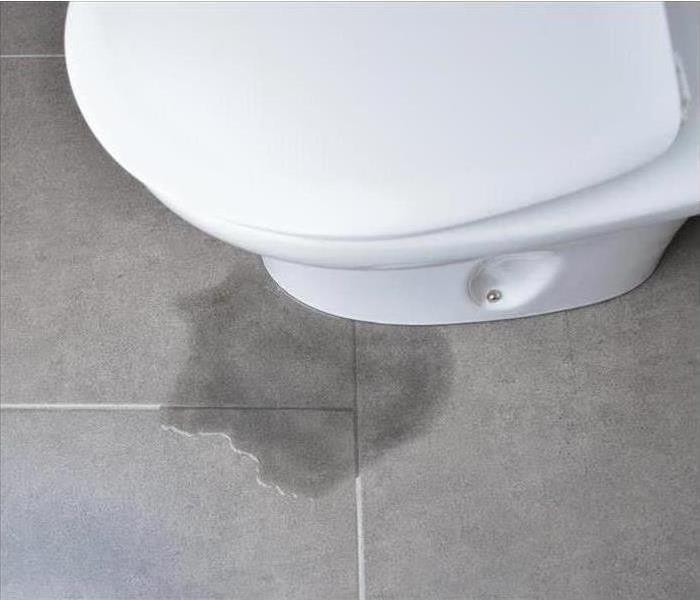 Leaking toilet in Salt Lake City, UT.
Leaking toilet in Salt Lake City, UT.
Although most commodes last for decades, they do need to be updated every now and then. If you have a leaking toilet in your home in Salt Lake City, UT, it might be time to replace it. Here are the steps to take to make this process as easy as possible.
3 Steps for Replacing a Leaking Toilet
1. Disconnect the Water Supply
Whether you are doing a toilet repair or installing a new one, never try to do work on a leaking toilet without disconnecting the water supply. This can lead to a large amount of standing water in your bathroom. In order to disconnect the water-supply tube you must loosen the compression nut on the shutoff valve.
2. Remove the Old Toilet
Depending on how long the old toilet has been in place, it may be stuck to the flooring. In order to remove it, you will need to unscrew any bolts and then gently rock it back and forth until it comes off the floor. Typically, there is a wax seal holding it in place, so you will need to break this before it will come off completely. If you are having trouble removing it yourself, you may want to call a professional to come help.
3. Install the New Toilet
Before you install the new toilet, you will need to get the area cleaned up, and remove any excess wax from the gasket. When you put the new one in place, make sure it is properly aligned. You can then secure it with the bolts. Some people choose to use caulk around the base to protect against mold growth. You should check with your building department to see if this is required in your area.
If you feel uncomfortable replacing the leaking toilet yourself, you should consider calling a water damage company in Salt Lake City, UT, to help you. They may also be able to work with you on the cleanup and check the extent of the damage. This may prevent larger or future issues from occurring.
3 Steps To Stop a Toilet From Overflowing
9/8/2022 (Permalink)
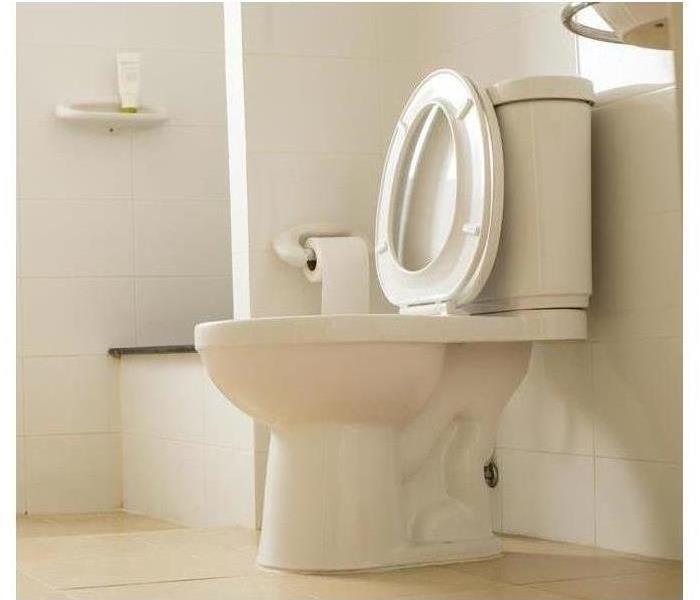 If you need to replace your toilet, contact a water damage mitigation and restoration company.
If you need to replace your toilet, contact a water damage mitigation and restoration company.
A drain line blockage can result in a flooded toilet. Homeowners can take three steps to stop a toilet from overflowing and limit the extent of sewer damage at a residence in Salt Lake City, UT.
Steps To Stop a Toilet From Overflowing
1. Contain Damage
Contaminated water can cause major water damage. If this water sinks into carpet or porous building materials such as drywall, these materials will likely need to be torn out and replaced. Use towels or a mop to stop the spread of sewage backup.
2. Use a Plunger or Snake
Once a homeowner has taken measures to try to stop the spread of sewer damage, he or she should address the cause of the problem. If the backup is due to a minor clog close to the floor drain, plunging a toilet may be enough to clear the clog and stop the overflow.
If the clog is more severe, insert an auger or snake into the toilet. Some augers have hand cranks while others can be attached to a power drill. It may be more effective to remove the toilet and snake the floor drain directly. You will need to use specialized tools and remove water from the bowl and tank or use a solidifying gel. Clear deeper clogs by snaking the drain cleanout in a basement or crawlspace.
3. Contact a Plumber
Calling a plumber can be easier than removing a toilet or dealing with a drain cleanout. If you do not have a snake or the skill or tools necessary to attempt advanced plumbing techniques, a trained professional is your best bet. If the problem originates in a municipal main, contact a sewage company.
If a flooded toilet causes extensive sewer damage, a homeowner should contact a water damage mitigation and restoration company located in Salt Lake City, UT. Experts can remove damaged materials, promote drying to prevent mold and restore the affected area.
3 Tips for Fixing a Flooded Basement
8/11/2022 (Permalink)
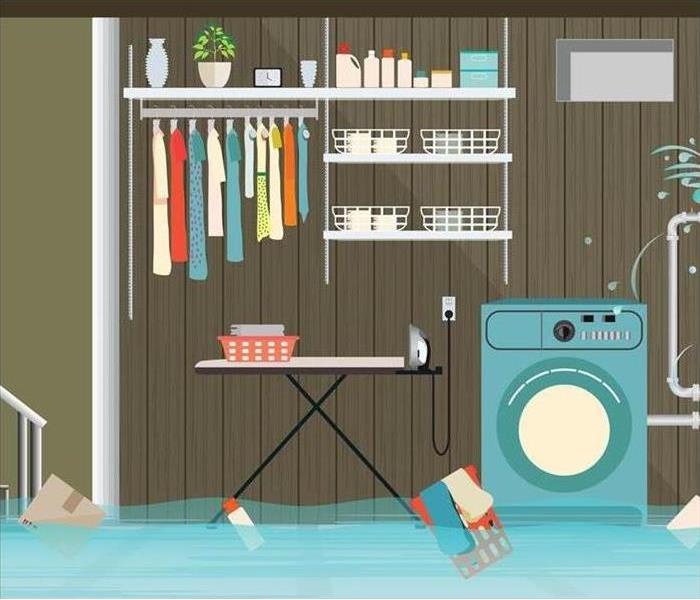 A flood in your basement can result in serious water damage.
A flood in your basement can result in serious water damage.
A basement flood can be a frustrating problem to deal with. If your home has a basement, it is important to familiarize yourself with what steps you can take to fix a flooded basement before a flood occurs. These three tips can help.
Tips for Fixing a Flooded Basement
- Remove the Water Before You Go in
Many basements have electrical appliances, wiring, and electrical panels that can create an electrocution hazard in a flooded basement. If you are dealing with a shallow flood, and you can access the service panel to turn off the electric circuits in the basement without going into the water, you may be able to remove the water using a hose from a shop vac on an upper floor. However, if the water level is above electrical outlets, it is best to call the fire department, rent a heavy-duty gas-engine pump or contact a water remediation company in Salt Lake City, UT, to assist you.
- Don't Try To Save Your Flooded Electrical Items and Appliances
The Gas Appliance Manufacturers Association and the National Electrical Manufacturers Association recommend replacing any mechanical or electrical equipment that has been exposed to a basement flood. Any fixtures, outlets, switches, wiring, electrical motors or appliances that have been exposed to flood water should be removed and discarded, rather than repaired. Check with your insurance professional if you need clarification about whether your insurance coverage will cover replacement versus repair costs for damaged items.
- Take Preventative Measures
Once you get your basement restored, take steps to prevent flooding from occurring again. Adding foundation drains, a generator to keep your sump pump operating during a power outage or a backup sump pump can help keep water out of your basement.
A basement flood can result in serious water damage to your home. These three tips can help you restore your home to preloss condition and prevent future problems from occurring.
Got a Sewer Backup? Get Professional Cleanup Help
6/17/2022 (Permalink)
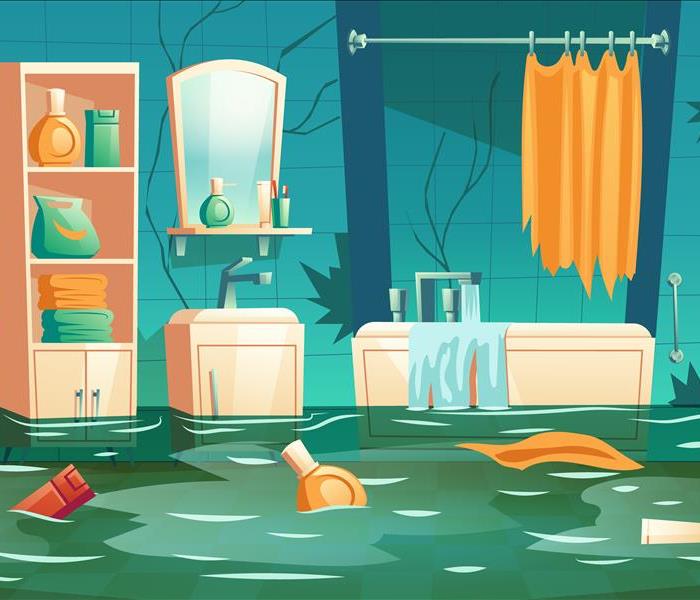 Got a Sewer Backup? Just call Our Specialists!
Got a Sewer Backup? Just call Our Specialists!
As a homeowner in Park City, UT, you want your home to be a safe and welcoming place. If you come into find the sewer has backed up, it means black water is seeping into the porous materials in the home and potentially spreading. Sewer cleanup requires extra attention to safety, which is why it’s best to call a water damage and restoration company to handle the mess.
Important Steps in the Cleanup Process
Sewer Backup Cleanup Process
Black water, classified as Category 3 by the IICRC, means that there are potential contaminants, bacteria, chemicals and microorganisms lurking within it. Even a flooded toilet may be in this category, so it’s important to not just dive right in.
Sewer Cleanup Process
When you hire a professional company, you get peace of mind that the entire problem will be handled by one trusted company. Trained and certified professionals will have the expertise, safety gear and industry-grade tools to get your home back to like new. While every situation has different degrees of severity, the cleanup process typically involves the following steps.
- Containment: Containing the affected area is the first vital step. This will help ensure that secondary damage doesn’t spread to other areas.
- Extraction: Standing water and waste will be extracted using high-grade pumps and other tools. The waste and contaminated water will be properly disposed of. Water-logged belongings will also be removed and taken off-site to be inspected for salvageability.
- Dry Out: Air dryers and movers, along with dehumidifiers, will be used to thoroughly dry the area.
- Clean, Sanitize, Deodorize: After the area is dry, the real cleaning process begins. An array of industry-recommended cleaning methods will be used to ensure peace of mind.
- Restoration: The final, and often longest step, involves restoring the property to preloss condition. This may include replacing drywall, carpeting, flooring and other structural components depending on the degree of damage.
Prevention Tips
Once you have dealt with a sewer issue, you don’t want a repeat situation happening. While there may not be much a homeowner can do if it was due to a city sewer issue, there are ways to minimize the risk in regard to your sewer line.
If it’s been a while since you have had your plumbing inspected, now is a perfect time. A professional plumber will inspect the valves and pipes to ensure they are working properly and have the know-how to detect potential problems.
The easiest way to keep your sewer working right is to practice good habits. Avoid flushing chemical products or any items other than waste and toilet paper down the drain. In the kitchen, ensure that grease is being properly thrown away and not going down the drain. This causes a buildup in the pipes that will eventually affect the main sewer.
While trees add to a property’s aesthetic, know where your sewer pipes are before planting. Tree roots will quickly make their way through older pipes, causing an eventual clog or collapse.
Sewer cleanup is a messy job and one that requires adhering to strict safety protocols. Instead of dealing with it on your own, it's best to consider hiring a professional to handle the job from beginning to end.
What To Know About Making a Residential Water Damage Claim
4/9/2022 (Permalink)
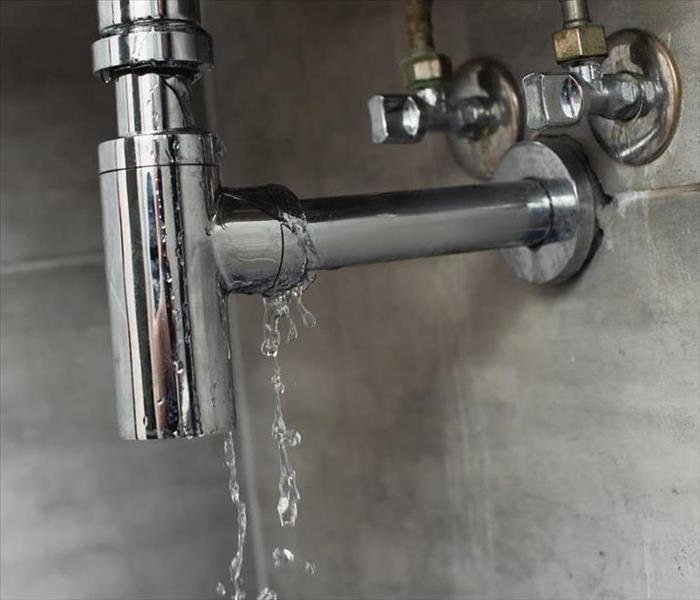 Know More about Residential Water Damage Claims by Following our Tips.
Know More about Residential Water Damage Claims by Following our Tips.
Making a water damage claim for your home can be a stressful experience. That is because homeowners' insurance policies are often confusing. Typically, damage caused by emergency situations, such as bursting pipes, is included in your policy. Other types of damage that may be covered include:
- Sewer backup
- Floods
- Storms
- Overflow
Yet even a robust policy does not cover all kinds of damage. Here are some things you should know before making an insurance claim.
When Is Water Damage Covered by Insurance?
Your insurance policy should cover a sudden and accidental discharge of water in your Salt Lake City, UT, home. However, most policies exclude coverage for gradual damage that occurs over an extended period.
Over time, parts of your home will experience wear and tear. This could result in water damaging various parts of the house. For instance, basement cracks could cause liquid to seep into the lower level of your home. A leaky pipe could also lead to a buildup of water inside your walls.
Insurance companies believe that you need to take reasonable steps to care for your home. That means inspecting the property regularly and fixing any issues right away. If your house suffers gradual damage, the insurance company will assume that you were negligent in your maintenance of the home and will likely deny your claim. You will then have to pay for water restoration services yourself.
Still, even this general rule has some exceptions. You may have to pay to replace or fix broken pipe yourself if the harm to the pipe occurred over time. However, the insurer may still cover any resulting damage that occurred as a result of the break.
Another common yet complicated situation occurs when a tree falls onto a roof and creates a hole. Your insurance provider will likely cover the costs of fixing the hole and addressing any damage caused by the water entering your home through the hole.
Yet what happens if you notice new water or mold damage near the hole months after the repairs have been completed? In this case, your insurer may still cover this additional harm if it was also caused by the original roof hole.
In general, mold is not covered by home insurance policies. Yet you may have coverage if the mold results from bursting pipes or another covered peril. Ask your insurance broker if it is possible to add mold coverage to your policy.
How Can You Decrease the Chances of Your Claim Being Denied?
There are several things you can do to prevent the denial of your water insurance claim. First, make sure to purchase a policy that addresses all of your needs. Do not be afraid to ask about any add-ons, such as mold coverage.
Performing timely repairs of your home is important, as well. Your claim will likely be denied if the provider determines that you have not been taking care of your property. Keep records of all repairs that you or a third party has performed over the years.
While damage caused by bursting pipes is often covered by insurance, your provider may reject other water-related claims. By performing regular maintenance on your home, you should increase the odds of your claim being accepted.
How To Repair a Leaking Faucet
11/24/2021 (Permalink)
 A leaking faucet can lead to water and mold damage in your Salt Lake City, UT home.
A leaking faucet can lead to water and mold damage in your Salt Lake City, UT home.
When your home is quiet and you suddenly hear the quiet sound of a leaking faucet, it's often the prelude to another home maintenance chore. Don't postpone this repair, though; that little drip can add up to gallons of wasted water and an increased Salt Lake City, UT, water bill.
5 Steps of Leaking Faucet Repair
Here are the steps you can take to fix the leak before contacting a water and mold cleanup and repair crew to address any damage:
1. Turn Off the Water
Start by looking underneath the sink. There should be pipes running along the wall with a handle for shutting off the water. Turn the handle clockwise. Once you believe the water is off, turn the faucet on in the sink to be sure. Next, plug the sink to prevent losing any hardware down the drain.
2. Determine the Type of Faucet
There are four common types of faucets: compression, ball, cartridge, and ceramic disk. The compression faucet has separate handles for hot and cold water, so it is easy to identify. You may need to disassemble the faucet to determine the other types of mechanisms. The ball faucet has a ball bearing inside the faucet. The cartridge and ceramic disk faucets have, respectively, a cartridge and ceramic disk within the faucet.
3. Gather Your Tools
Before you start taking the faucet apart, gather the supplies you'll need. These include a bucket, some towels, and rags, an Allen wrench, an adjustable wrench, some needle nose pliers, slip joint pliers, and both flathead and Phillips screwdrivers. You will probably also need a faucet repair kit and some fresh O-ring seals. Make sure you have an area to lay the parts of the faucet, so they don't get lost.
4. Identify the Source of the Leak
Once you have taken the dripping faucet apart, look for a dried-out or worn rubber washer, a piece of broken hardware, or gaps between mechanisms. The specific steps for repairing or replacing parts vary by type of faucet. For example, repairs to a cartridge faucet often involve cutting out old O-rings and using a plumber's grease when installing new rings. In a compression faucet, you can generally pull the washer out; however, you do need to have the exact match for a good repair. You can usually find the specifics for your leaking faucet online or at your local hardware store.
5. Reassemble the Faucet
After you've replaced the damaged components, put the faucet back together. If you're not sure, refer to the instructions on the repair kit or use an online how-to video. Don't put your supplies away, however, until you have tested the faucet. There shouldn't be any drips from the faucet after a successfully fixed leak.
Contact Professionals To Prevent Mold
After completing your leaking faucet repair, it's important to contact mold and water damage professionals. It doesn't take long for a small amount of hidden moisture to develop into a thriving mold colony. You may not spot any mold right now, but when you can see or smell it, the problem has already become significant. Remember that prevention and quick action is the best way to limit the expense of mold remediation.
Black Mold and Secondary Water Damage
10/6/2021 (Permalink)
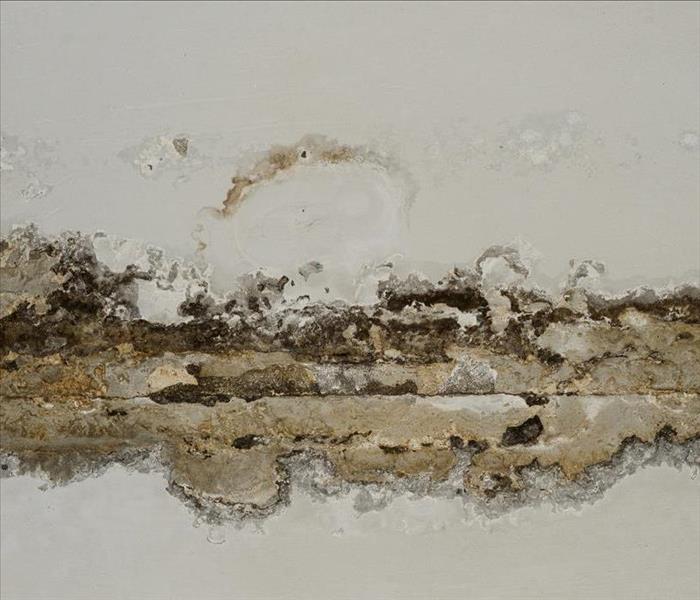 Water damage in your Park City, UT building leads to black mold and further damage.
Water damage in your Park City, UT building leads to black mold and further damage.
An emergency pipe burst or trouble along the sewer line can quickly put the brakes on your daily operations. Your quick efforts to deal with the source of trouble, to remove the water, and to thoroughly dry your facility can prevent a lot of further problems. Unfortunately, it is possible for water to soak into carpeting or drywall and for humidity to build-up, allowing for the growth of black mold and other forms of mildew.
Dealing With Black Mold and Other Damage
The first step in tackling secondary damage from any type of water leak or flooding is understanding the problem. Learn as much as you can about the types of damage you can expect:
- Mold growth
- Rotting materials
- Peeling vinyl and paint
- Warped wood
- Compromised electrical wiring
- Corrosion and rust
As you come to fully understand the havoc caused by hidden pockets of moisture and high humidity, you're better prepared to aggressively target those problem areas.
Understanding the Causes of Further Damage
One of the main reasons properties suffer from black mold and other forms of damage are that flooding, leaks, or spills weren't properly mitigated the first time around. Certified cleanup and mitigation professionals are trained to prevent secondary harm, protect your building from lasting damage, and save you a lot of money in ongoing repair costs.
As a property owner, you may be a fastidious cleaner with a determination to properly repair and clean your facility. However, there are several areas where moisture builds without giving notice of the trouble brewing:
- Humidity buildup in the air conditioner
- Damaged appliances with hidden leaks
- Hidden moisture beneath or behind surfaces
It isn't uncommon for property owners to thoroughly clean and dry their buildings, only to discover later on that damage, such as mold growth
Taking Action Immediately
It doesn't take long for water to cause a lot of expensive damage. It is vital that you act immediately for the protection of your building. This means shutting off the main source of water, contacting cleanup crews right away, and getting all available hands involved in the cleanup. If it's possible to remove carpets from the floor, you may prevent an expensive loss of flooring.
Avoiding Secondary Problems
In addition to hiring professionals to help you recover from water damage, there are steps you can take to prevent further trouble. Once you've dealt with the immediate flow of water, open doors and windows to provide thorough ventilation. Remove water and water-logged furniture, equipment, and belongings as quickly as possible. If it's safe to use the electricity in your building, set up fans in the affected area. Be sure that there's a consistent flow of air through unaffected rooms so that humidity doesn't build up and cause new damage.
For the best results, choose a Park City, UT, professional company to deal with water damage before your experience any type of trouble. This proactive step ensures that you or your employees know who to call, so professionals arrive as soon as possible. The better you understand black mold and other secondary harm, the better able you'll be to take prompt action and avoid a lot of expensive damage.
How Do I Make a Water Damage Insurance Claim?
9/16/2021 (Permalink)
 Filing an insurance claim form correctly is essential to get your Park City, UT home restored faster.
Filing an insurance claim form correctly is essential to get your Park City, UT home restored faster.
Water damage is one of the most common reasons homeowners file an insurance claim. To get your claim processed quickly, it is helpful to familiarize yourself with the claims process before you need to make a claim.
How To File a Homeowner's Claim
Filing a homeowner's claim is a multi-step process. Proceeding through the steps in order will help you make sure you don't forget to do anything.
1. Read Your Policy
Your policy should explain what your responsibilities are and what types of damage are covered by your policy. This is particularly important for water damage claims, because most homeowner's policies cover water damage from sudden and accidental discharges, such as a pipe burst, but exclude damage from a flood.
2. Mitigate Your Damage
Most insurance policies require homeowners to mitigate their damages. This means that if there are reasonable steps you can take to prevent additional damage from occurring while you are waiting to get the initial damage repaired, you are expected to take those steps. An example is shutting off the water to your home when you have a leaking pipe. If you have to spend any money to make temporary repairs, save your receipts. Your insurance policy may cover these costs.
3. Contact Your Insurance Company
Call your insurance agent or the claims office of your insurance company as soon as possible to begin the process of filing your insurance claim. Ask any questions you have about your coverage and deductible. Find out how long it will be before repairs can begin. Ask if you need to get an estimate done or if the insurance company will be sending someone out. Drying your property out promptly is important, so you may want to inquire about hiring a water remediation company in Park City, UT, to begin that process.
4. Complete Claim Forms and Other Paperwork
Your insurance company may mail your forms or allow you to complete them online. It may also ask you to submit other documentation. Return the requested materials as soon as possible. The longer you take to furnish the requested documentation, the longer it will take to process your claim.
5. Prepare for the Insurance Adjuster
In most cases, your insurance company will send an insurance adjuster to inspect your home and estimate the amount of damage. Take photographs of your damaged property and make an inventory of everything that was damaged. Gather together any receipts or other documentation that proves the value of your damaged property.
6. Keep Your Receipts for Relocation Expenses
If your home is uninhabitable because of the damage, keep your receipts for the cost of hotel rooms or rent for the period of time you are unable to live in your home. You may also be reimbursed for other additional living expenses, so keep the receipts for anything you had to spend money on because you were unable to occupy your home.
Filing an insurance claim for water damage can sometimes be confusing, but your insurance professional should be able to answer any questions that you have. Promptly and correctly filing your claim is critical for getting your home restored as quickly as possible.
Confront the Damage From a Flooded Toilet
8/11/2021 (Permalink)
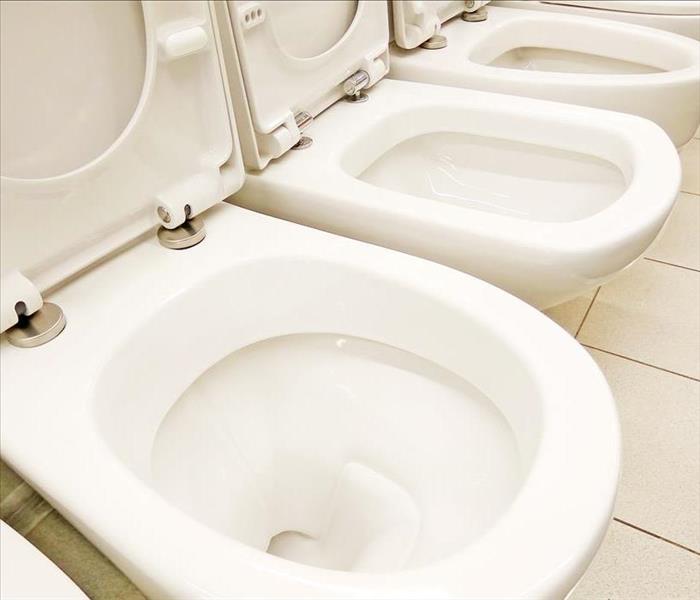 The damage caused for a flooded toilet in your business in Salt Lake City, UT, must require professional help.
The damage caused for a flooded toilet in your business in Salt Lake City, UT, must require professional help.
The sewer damage that results when a flooded toilet overflows throughout your Salt Lake City, UT, a business can quickly add up to a lot of money. The good news is that your commercial property insurance policy probably covers a lot of the damage. With this in mind, it's important that you know which steps you can take yourself and which work should be left to professionals.
Take These Steps Immediately
As soon as you notice the flooded toilet, you need to complete a few vital steps:
Turn off the water. You can do this by lifting the float inside the toilet tank, turn off the valve at the back of the toilet, or shut off the water at the building's water main.
Mop up as much water as possible. It doesn't take long for water to cause expensive damage to your building.
Clean up organic matter. This includes dirt and other substances that may have been in the toilet. You must be aware of the dangers of black water, at this point. The bacteria from waste in the water can have serious side effects, especially during extended contact.
Contact sewer damage cleanup and remediation professionals. In addition to handling any black water and other dangerous contaminants, these experts may point out potential areas of mold growth and help you avoid future water damage.
If the flooding is confined to a small area, you may clear the clog and clean up the mess on your own. However, if there's any possibility that you're dealing with anything other than clean water, you're better off turning the job over to professionals. Depending on how widespread the damage extends, you may need to take additional steps, such as contacting the sewage company.
Respond to Further Damage
If water from the toilet has traveled from one floor of the building to another, it may be necessary for cleanup crews to tackle some demolition and reconstruction. For example, flooring and ceiling materials may need to be removed, disposed of appropriately, and then replaced. Wet materials, including drywall and insulation, may need to be thoroughly dried out, disinfected, or replaced. Your insurance company may require you to work with damage cleanup and remediation professionals.
Prevent Mold Growth and Damage
Mold is a common concern after any type of water damage. High levels of moisture can cause unseen pockets of humidity that provide an ideal breeding ground for mold spores. Unfortunately, within just a couple of days, there may be enough mold growth to encourage the spread of multiple colonies. If you don't know what to look for, this trouble could continue unseen until serious damage has been done. Cleanup technicians may test for mold and take steps to clean up and prevent spread.
Avoid More Unpleasantness
Cleaning up after an overflowing toilet isn't one of the things that most business professionals are excited about. However, when sewer damage happens, these simple steps can help keep further damage under control. Your quick response and the work of professionals is the best way to limit further harm and get your business back underway.
Out with the Old: Changing your Pipes
8/4/2021 (Permalink)
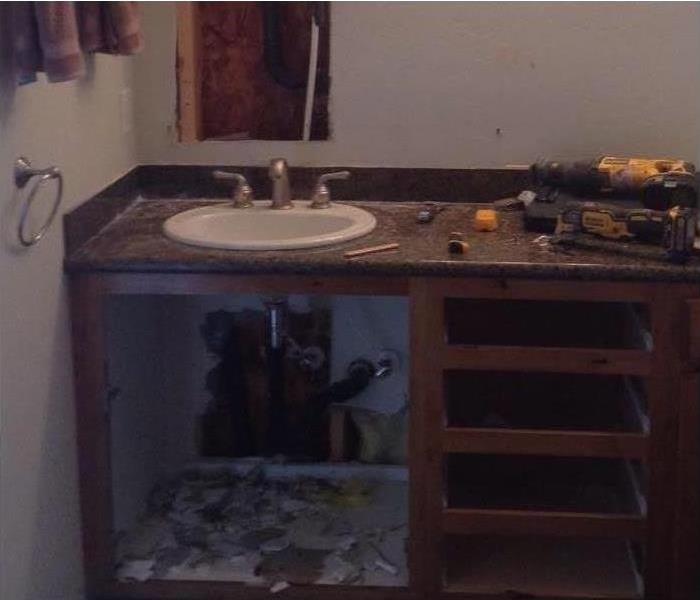 Broken pipe causing water loss in a Park City, UT home
Broken pipe causing water loss in a Park City, UT home
From the 1970s to the 1990s, a specific sort of pipe was used in a lot of commercial plumbing. Polybutylene was thought to be the pipe of the future because it was inexpensive to make and easy to install. After a few years, however, those buildings started having plumbing problems. These pipes are not used in Park City, UT, today because they inevitably wear out, and they cause significant water damage when they do.
Here are some reasons these pipes must be replaced if they are part of your building's plumbing.
1. Exposure to treated water makes it brittle. One of the reasons this particular piping does not work for plumbing is that the water itself destroys the pipe. The chlorine and antibacterial chemicals used to make drinking water safe make the polybutylene pipes brittle and prone to breakage. Over time, they cannot be fixed. They must be replaced.
2. Disintegrating parts get stuck in the water. Another startling effect of this type of piping is that as it disintegrates, it flakes off and leaches chemicals into the water supply. New plumbing made from safer materials is a necessary upgrade.
3. It costs more to maintain than to replace. Replacing these pipes has a comparable cost to replace the carpet in your house. The piping change isn't inexpensive, but neither are all the costs from having to hire water remediation experts to clean up every time you have water damage.
4. It drives down the resale value of your building. Because this piping causes so many problems, it needs to be fixed before you put your property on the market. Most realtors won't even show a commercial property that still has old pipes in it. The pipes must be replaced before the building is likely to sell.
If your commercial building seems to have more water damage problems than it usually does, polybutylene pipes may be the culprit. Have the pipes replaced to avoid additional repair expenses.
4 Advantages of an Electronic Claims Service
6/28/2021 (Permalink)
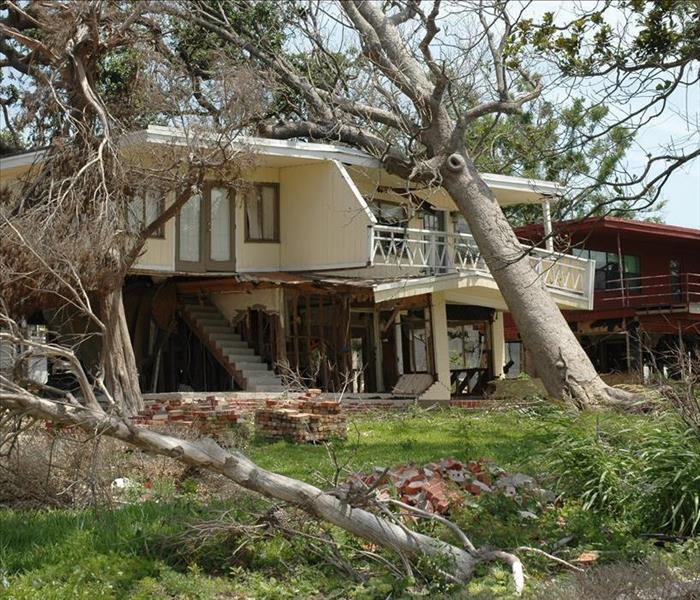 Utilizing an Electronic Claims Service has its benefits.
Utilizing an Electronic Claims Service has its benefits.
When your home is hit by a disaster in Salt Lake City, UT, immediate action is necessary to minimize loss. First, you must call to get your insurance agent to inspect the damage so that you can file an insurance claim. Then, restoration can finally get underway to minimize loss. These days, with the help of SERVPRO electronic claims service, the process is becoming increasingly faster and more efficient, allowing for numerous benefits.
Benefits of an Electronic Claims Service
1. All the Data Is Saved in One Secure Location
Every stage of the claims process is documented and placed on the electronic claims service site. These days, there's very minimal, if any, sorting through piles of paperwork and looking on multiple company sites. Electronic claims services enable professionals to obtain all your damage information from one website. They can also access it from any computer or mobile device, whether in the office or the field.
2. The Information Is Updated and Accessed in Real-Time
As soon as a professional uploads information to the database, it's available for others to access. This enables a smoother insurance claim and restoration process with less downtime.
3. The Agents, Adjusters and Service Providers Have Access
From insurance agents and adjusters to damage restoration specialists, everyone can access your information about the entire ongoing process at all times. The service also provides professionals access to nationwide collected data from various types of claims to make sure you receive fair costs and compensation.
4. Communication Is Made Easier for Everyone
Property owners, insurance agents, adjusters and service providers have an easy line of communication throughout the entire process. Everyone involved can simply go to the account and interact with one another.
An electronic claims service makes filing an insurance claim a simple, efficient procedure from start to finish. Whatever type of disaster your home endures, this technology is invaluable. The damage to homes is mitigated and restored faster than ever.
Alternatives to Using Chemical Drain Cleaners
4/16/2021 (Permalink)
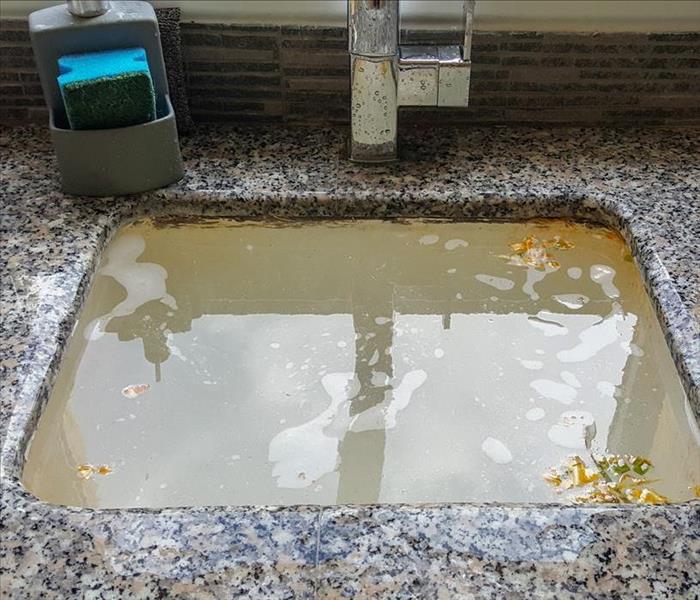 Clogged drains can cause damage to your home.
Clogged drains can cause damage to your home.
A chemical drain cleaner is a powerful tool when it is used correctly in a clogged drain. However, they can cause damage in the wrong situation.
The chemical cleaners produce heat, and this can lead to damage:
- Weakened older pipes may develop cracks and leaks.
- Plastic pipes may become warped and misshapen.
- If the drain is completely blocked, the chemicals will sit in one place and eat through the pipes even if they are relatively new.
In addition to these risks, the chemicals could harm you and your environment:
The chemicals in drain and sewage cleaning products are toxic and are generally more damaging to skin than to plastic and metal pipes.
Even breathing the fumes could lead to irritation.
Before you treat your drain with chemicals, consider the risk of damage to the piping system. It may be worth your time to reach out to water damage cleanup and repair professionals.
How Chemical Cleaners Work
If you understand how drain cleaners work, you'll be better prepared to make the right decision about whether to use them in a clogged drain. There are three types of chemical cleaners:
Although the makeup of these products are different, they all cause a chemical reaction, either adding electrons or removing them from the gunk in your pipes. However, as the fats, oils, and grease break away from the clog, they simply move further down the drain and end up forming a new clog deeper in your pipes.
Alternatives to Drain Chemicals
There are two methods you could try before pouring chemicals down your drain. First, you can try manually clearing the clog. Secondly, you could try a non-toxic enzyme cleaner that introduces living bacteria or enzymes into the pipes. This option may take 24 hours or so before you see results.
For the Best Results
Professional cleaners are some of the best Salt Lake City, UT, professionals to address your clogged drain issue. If you have already put a chemical in the drain, be sure to alert the technicians before they start working.
Where to Start when Restoring a Flooded Basement
1/18/2021 (Permalink)
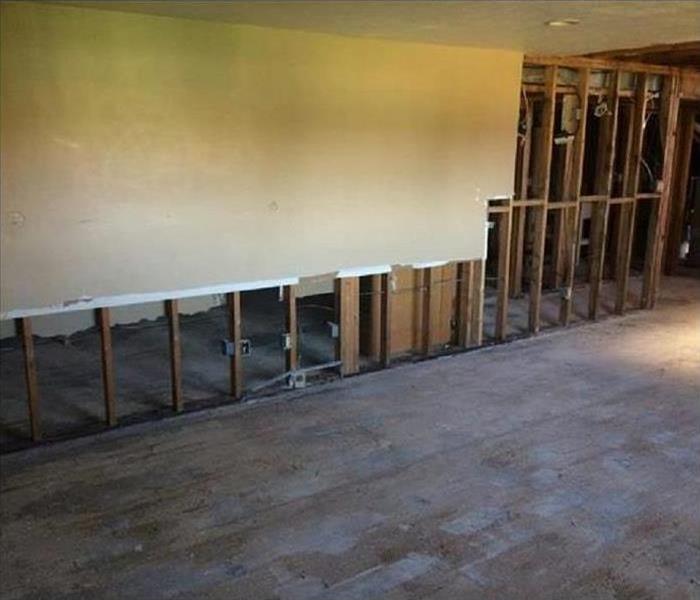 SERVPRO performed flood cuts to remove all water damaged materials in Park City, UT.
SERVPRO performed flood cuts to remove all water damaged materials in Park City, UT.
When flood season comes to Park City, UT, it can hit hard. The impact of the excess water is most likely to be felt by homeowners in the form of basement flood damage. Whether the sump pump failed or just couldn't keep up with the water flow, homeowners may be left scratching their heads. Feelings of where to start and what to do can be overwhelming. The following three steps may give some direction as to how to approach flood cleanup and prevention of future incidents.
3 Steps to Cleanup Flood Damage
- Remove Water
Before any repairs can be made, all of the water must be removed from the basement. Some people prefer to call a water removal and restoration company for assistance. Flooded basement water removal may look something like the following:
- Hiring an electrician to evaluate the risk of electric shock.
- Getting the sump pump up-and-running to remove sitting water.
- Using a shop vacuum to suck-up the last inch or so of water.
- Lifting carpet and using large fans to dry-out moisture.
- Sanitizing with warm water and disinfectant to prevent mold growth.
- Repair Damage
Once the area has been completely dried, repairs may be in order. Checking your home flood insurance coverage may be a good place to start. While salvaging some belongings may be an option, it is unwise to try to save anything which uses electricity or gas. If your gas furnace or electric outlets took on water in the flooding, replacement over repair is the safe route to go.
- Plan for Future Flood Prevention
Now that the basement is clean, dry and repairs are complete, it's time to plan ahead for the future. There is nothing worse than putting time and money into basement flood restoration only to have it ruined all over again. Consider the following preventative measures:
- Install a back-up pump.
- Create outside drainage for storm runoff.
- Buy a generator for use during a power outage.
Flooding in Park City, UT, is common. If a basement flood catches you by surprise, follow these three basic tips to get cleanup underway.





 24/7 Emergency Service
24/7 Emergency Service















